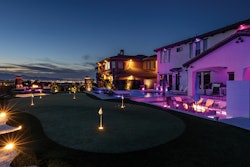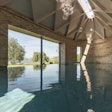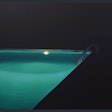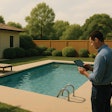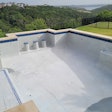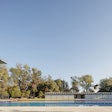
Sometimes, a home just needs a little encouragement to showcase and enjoy what already is right in front of us.
Although many would consider this project's apparent scope to be "just a basic pool remodel and spa addition," I knew it could be so much more. Completed in April 2020 in the refined neighborhood of North Scottsdale, Ariz., it celebrates the surrounding landscape and is an example of how lighting can take an environment to a whole new level — enlivening the senses and creating a heightened experience of joy.
I looked to renowned international lighting designer Janet Lennox Moyer to partner with in obtaining just the right amount of illumination combined with a cunning pool design to create this remarkable transformation. (I also thank the team at Red Rock Contractors in Arizona for bringing this project to life.) Together, we knew we could amplify this home's overlooked and underappreciated features to create a compelling, artful backdrop. In this case, those features include existing and imported trees, cacti and ground plants indigenous to the American Southwest.
Prior to its remodel, the rectangular pool was more than 15 years old and mundane in its current form, reflecting intense glare in the Arizona sun — courtesy of a light interior and a wrap-around travertine deck. It offered no reflective aesthetic, became pitch black at night, and all but ignored a picturesque and mature mesquite tree that anchors the far corner of the pool.
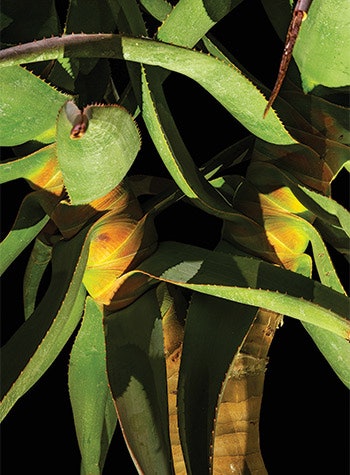
Deepening the pool's interior color with Pebble Sheen's deep-green Turtle Bay was my top strategy and yielded much more vivid reflections. After accompanying me on visits to similar projects I had completed, the oncehesitant homeowners came to realize that a darker pool interior would not necessarily give off an ominous or murky vibe.
We also replaced the stark white deck material on the two background pool edges with a freeform blanket of artificial turf, wrapping the setting in a blanket of dark green up to the water's edge. Diminishing the brightness of the pool and deck foreground surfaces allows for the unfettered, twisted shape of the mesquite tree to be the star.
All told, the 85 LED lights installed around the yard's perimeter, in the trees and along the eaves of the home, result in a shimmering mirror effect on the nighttime water surface. Thanks to strategic lighting throughout the backyard, the homeowners no longer gaze into a poorly lit void. Instead, they look out into the backyard every night and are blown away by their newly discovered living space.

JAPANESE DESIGN INFLUENCE
When I was a student at Arizona State University, I took a career test that indicated I should become a landscape architect. Even though I had been to Japan and had great admiration for the outdoor gardens there, I neither believed the results of that test nor understood yet the significance that landscape architecture plays in the world we enjoy.
My naïve image of a landscape designer was someone who played a fringe role, simply filling in the gaps between the architecture and the parking lot. Today, I recognize that landscape design, when implemented properly, is the key differentiating factor in how well homes and pool areas celebrate the expansive and freeing sense of space.
How can we expand a home to make it feel larger than it is? By not confining interior spaces and not limiting the backyard concept to just the pool. The heart of creating luxurious interior living involves expanding those spaces outward to the exterior, as an extension of the home: Bring the outdoors in.

Landscape lighting, artfully employed, is the crowning expression of bringing the outdoors in, and I aim to elevate a project's natural elements to the level of art itself — like a Japanese garden. This project's anchor element in its garden setting is the twisted form of a majestically shaped mesquite tree.
THE 'DRAMA PIECE'
The first time I saw the mesquite tree, I realized this project could be extraordinarily special and a real surprise to the owners — if I could figure out the best way to show it off and make it the backyard's centerpiece. The tree is beautifully formed, an object worthy of your gaze, and it occupied the diagonally opposite focal area behind the pool. I knew I had to light it up and anchor the entire project around it.
In other words, this was the money shot.
To show off the tree's grandeur and character, we needed to spread the light throughout its entire form and make the context around it as easy on the eyes as possible. This strategy requires a quantity of fixtures that most designers shy away from, fearing the result will look like a "landing strip beacon." The secret? More fixtures but with less wattage to paint light evenly throughout, rather than having glaring hotspots and then vast areas of darkness.
The intentional distribution of light is akin to that in a photography studio. Think of the last time you had your portrait professionally taken. Multiple lights from multiple angles, including backlights from behind you, were used to highlight and accentuate your 3D form, putting you in your best light.
That same strategy was in play here. We installed six discrete, low-wattage ground and wall-mounted fixtures to highlight the tree's rugged trunk and canopy from the ground up, as it begins spiraling 40 feet toward the sky.
Downlight fixtures, seven in total, were suspended within the tree. Their illumination connected the mesquite's presence with surrounding natural elements, anchoring the tree to the ground.
Here's a simple yet profound strategy I learned from Janet: When you apply lighting to a tree, do not place fixtures directly under a branch; rather, locate them under a void. This allows the light to fully translate all the way up into the canopy, creating a glow from within. The added benefit is that the branches at the base are lit more softly by this side placement instead of glowing hot from having a light right beneath it. This approach eliminated excess shadows and enhanced the clarity of the mesquite tree's reflection
in the pool water.

SUPPORTING ROLES
Three Mediterranean fan palm trees — a single tall one in between two shorter ones — flank the far side of the pool and serve as the key focal element from within the home's living area and frontentry view corridor. Low-wattage ground lights mingle with higher-wattage ones to create a dramatic scene that makes the trees look as though they are lit from within.
Just beyond the palms, on the other side of the existing perimeter wall, stands a magnificent saguaro — a highlight of the backdrop that we didn't want to go dark. So, we jumped the wall and installed three uplights out in the desert. The saguaro behind the mesquite tree was also lit, from both the ground and a suspended light in a tree branch above.
Background walls, as seen behind the mesquite, can doubly serve as "screens" upon which to project shadows. While the agave blue glow and other ground elements (Aloe Hercules and Aloe Barbadensis) are illuminated from above by the suspended lights within the mesquite tree, these alone were not enough to fully reveal the 3D forms of these sculptural pieces. Multidirectional lighting from the sides of each specimen vividly accomplished that.
For a sense of hierarchy, we left the background area darker. The stars of the show receive brighter illumination; subordinate characters get lesser light, and backgrounds are even darker. It's just like a movie set or theatrical stage.
I aim to treat surrounding elements with the respect they deserve while not diminishing the impact of the main features. But I don't drape them in total darkness either, because the contrast will be too great.
NO 'RUNWAY EFFECT' HERE
Another key strategy employed on this project is the degree of light emanating from the eaves of the home and the canopy of the patio-centered ironwood tree. It takes a lot of work and willpower to determine exactly where to install lights and run wire into the architecture, as well as to persistently seek out exact tree limbs from above. That's why so many backyards default to path lights and step lights, imparting a cheap, runway effect. This easier default strategy results in a hideous and distracting endgame in which the fixtures themselves become features, siphoning attention away from what you are supposed to be looking at. Take great lengths to avoid path and step lights whenever possible. Though the cost per fixture of integrating downlighting is high because of labor and strategizing, the results speak for themselves. Seek to illuminate and hide the source discretely above.
Though the cascading stair from the home down to the pool deck is quite long (20 feet), not a single step light was used. Risers are illuminated by two eave-mounted lights, and the patio ground plane around the tree's base glows courtesy of six suspended ring-mount lights. The planter along the house indirectly illuminates the living space that it borders. Fourteen downlights along the length of the house fill in these perimeter planter areas, defining borders.
We also ran lights below the deck into the patio tree planter to uplight the ironwood tree's trunk and buried a flush to grade uplight in the lawn near the edge of the tree's drip line. The result of this extra effort highlighted the ironwood and elevated its status to an art piece worthy of reflection, one that can fully be appreciated from the spa looking toward the house. When both large trees are illuminated at either end of the pool, the ironwood and mesquite trees bookend the space and provide a balanced, comforting sense of enclosure.
A lady slipper plant, wild and unruly, is the singular player in a bright blue pot that adorns the planter island at the stair descent and dining area. The focal pot adds a dash of color accentuated by lighting from the eaves above that overflows onto the nearby patio steps.
Counterintuitively, we don't light pathways themselves. In this case, we lit what's in the planter next to the pathway. By virtue of singling out the planter, we've delineated the pathway. Your mind fills in the blanks.
From the beginning of this project, I knew we could fill in a lot of blanks, and it took a team to get all of the pieces to work together. I have heard some people refer to this type of comprehensive approach to lighting as overkill. But my mindset is to recognize the preeminence of the landscape backdrop; it's even more important than the pool itself. Because of that perspective, I understand how to convert a basic pool into something extraordinary. With this project, the backdrop was already there; we just needed to unveil it.
The true transformation of this remodel project was not what we did to the pool — although that played a major role in the overall effect. Rather, it was the way we leveraged the beauty within the existing landscape, showcased it and elevated it to a piece of art.
Photographing Lighted LandscapesOne way to learn the art of lighting is to hire and accompany a master photographer on photoshoots of your projects. This will allow you to view the way he or she lights each space in an effort to capture pristine images. In some cases, the photographer might need to create a composite of multiple images to achieve the perfect shot. Watching one of my photographers work that way helped accelerate my understanding of proper landscape lighting placement. My goal became to create in real life (as much as possible) what he was creating in the lens of his camera. With assistance from lighting designer Janet Lennox Moyer, I am now able to light my projects in such a way that they do not require flash photography to be captured on film after dark. All the photos shown on these pages are long exposures but otherwise, did not need supplemental light to achieve what you see on the page — because we lit the project evenly and completely. They are as close to the real thing as you can get. |
Commentary from Janet Lennox MoyerKirk Bianchi has a way of getting to the heart of what his clients want and how they live, ultimately giving them a beautiful and comfortable outdoor-living environment. My role is to help Kirk understand the lighting opportunities available with each project and increase his working knowledge of what lighting can accomplish. He usually involves me early on in the life of a project, and I assist in selecting the appropriate equipment — everything from lamping output, candlepower and beam spread to fixture type — taking into account function and aesthetics. We look at power distribution to provide the project a good electrical base for both now and in the future, and then we wait. So much can change from conceptual design to a built landscape that we often end up getting different fixtures (or a different quantity of fixtures) because of how the site actually develops during installation. The final step in landscape lighting is to "aim and adjust" the equipment that has been wired and located. As much design happens in this phase as in the conceptual design. We may change the lighting output (too much or not enough), alter the beam spread (too narrow or too wide), or re-aim or relocate fixtures to create the best effect. Regardless of what we do, it always feels like magic occurs. Clients watch us make changes — major or minor — and express surprise and satisfaction at these last-minute improvements. Pools are a major element in a landscape, but they are only a single element in the overall composition. Professional pool designers and builders can offer their clients a whole different experience by planning the lighting landscape surrounding the pool. Get them thinking about nighttime activities anchored by the pool: barbecuing, cocktail or dinner parties and relaxing around the fire pit. Offer the owners a complete night-living space. Janet Lennox Moyer is an internationally known lighting designer with offices in Glen Rock, N.J., and Rio Verde, Ariz. She is the recipient of many design awards and the author of The Landscape Lighting Book (Wiley). |




























